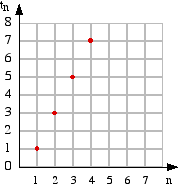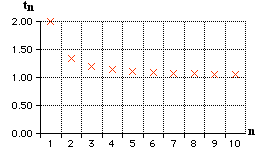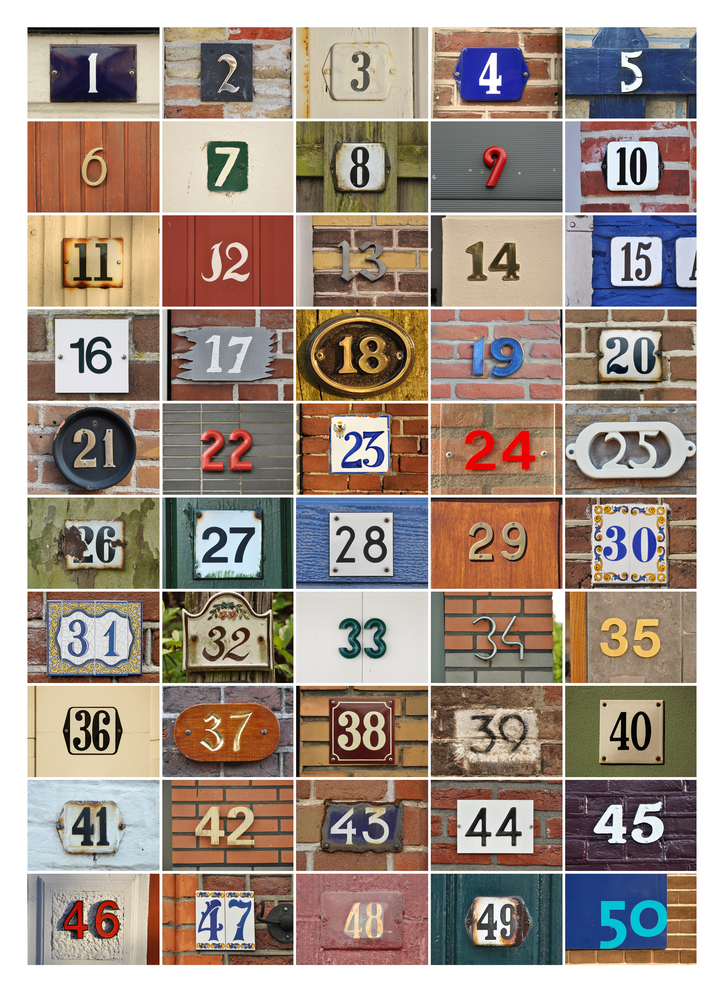 A sequence is a set of numbers arranged in a particular order.
A sequence is a set of numbers arranged in a particular order.
Sequences can be:
finite, a fixed number of terms e.g. 3, 4
or
infinite, going on forever e.g. 3, 4, 5, 6,...
This course studies infinite sequences.
Many sequences have a mathematical pattern.
Arithmetic and Geometric sequences are examples of sequences with a patterns and are studied in the next two topics. Sequences can be enclosed in triangular brackets. < 3, 4, 5...>
Notation
Each number in a sequence is called a term. There are various ways of describing terms.
The first term of a sequence can be given by t1, t(1), T(1) or T1. We will use t1.
The general term or n th term is written as t n.
There are four ways to express a sequence.
|
Method
|
Explanation
|
Example
|
| By listing | List the first four or five terms in order. | 2, 8, 23, 68... |
| By formula for the n th term |
A formula is provided to work out any term of the sequence. |
<3n + 2> or t1 = 3n + 2 First term, t1 = 3 x 1 + 2 = 5 The sequence is 5, 8, 11... |
| By a recursive function |
One term is provided and a formula is given to work out the following term. |
t 1 = 3 ,t n + 1 = 2 t n + 1 First term is 3 The sequence is 3, 7, 15... |
| By graphing |
The sequence is illustrated on a graph. The horizontal axis is the number of the term. The vertical axis is the term itself. |
Graph < 1, 3, 5, 7... >
|
Sigma Notation
Sigma notation uses the Greek letter capital sigma, ∑ to show that the members of a sequence must be added.
Think of ∑ as meaning "the sum of".
e.g. ![]() means add together the four terms made by putting n = 1, n = 2, n = 3 and n = 4 into the expression 2n + 3
means add together the four terms made by putting n = 1, n = 2, n = 3 and n = 4 into the expression 2n + 3
|
|
= (2 x 1 + 3) + (2 x 2 + 3) + (2 x 3 + 3) + (2 x 4 + 3) |
| = 5 + 7 + 9 + 11 | |
| = 32 |
A mathematical series is obtained by adding the terms of a sequence of numbers together.
The next two topics cover arithmetic series and geometric series.
A given series can be written in sigma notation.
The series 31 + 32 + 33 + 34 + 35 could be written as ![]()
Sometimes if the variable is obvious, as above, where it is n, then the n may not be displayed above and below the sigma symbol.
Spreadsheets and Types of Sequence
Sequences can be generated on spreadsheets and then graphed. The table below shows how to do this for several types of sequence.
|
Increasing Sequence t n+1 ≥ tn
|
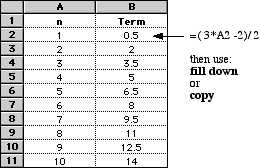 |
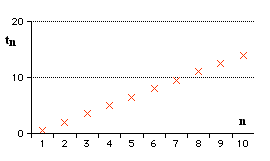 |
|
Decreasing Sequence t n+1 ≤ tn |
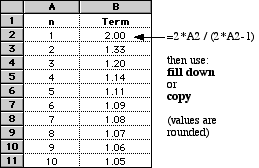 |
This sequence is bounded belowby the line tn = 1 |
|
tn =(-3)n Oscillating Sequence Alternates in sign from positive to negative or above and below a fixed line. |
 |
 |
A sequence such as tn = 4 is called a constant sequence and its graph would show it terms to be in a horizontal line.
Convergence
The terms in the second sequence in the table above can be seen to be getting closer to the value 1.
The value 1 is said to be a limit for the sequence and the sequence is said to be convergent. The sequence is said to converge toward 1.
The first and last sequences in the table are not convergent, the terms diverge.
Example of a converging sequence
|
Recursively defined: t1 = 1 t n+1 = 0.8t n Decreasing Convergent Sequence (converges to 0) |
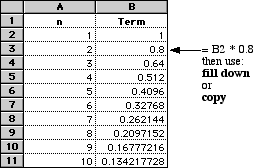 |
The sequence above is said to be bounded below by the line tn = 0. |
